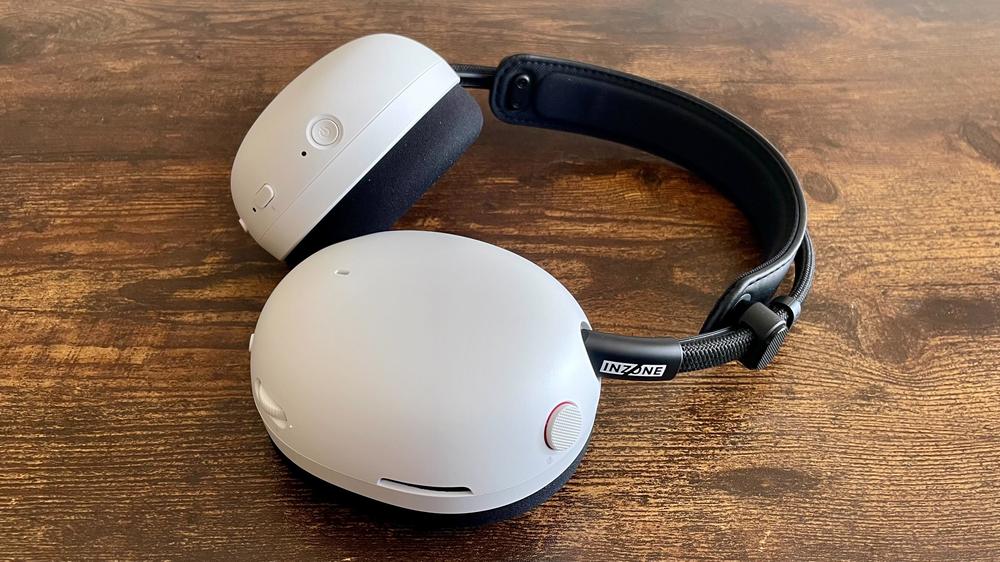Some of the best gear comes with a hefty price; it's something I try to at least contextualize when reviewing something in a higher price tier like the Sony InZone H9 II headset. With it sharing the same audio drivers as the high-end Sony WH-1000XM6 headphones, you may think you're getting a bargain, yet compared to the top gaming headsets, the InZone H9 II hits the upper limit in price. So it's in an interesting position, and after using it for a week straight, Sony's new enthusiast gaming headset has a lot going for it, even at $350. It's stiff competition when looking at the all-timers in the Audeze Maxwell or SteelSeries Arctis Nova Pro (and doubly-so with the brand-new Arctis Nova Elite that blew us away), but it's a smartly designed headset especially if competitive gaming is your primary focus.
Sony InZone H9 II – Design and Features
Unlike most of its contemporaries, the InZone H9 II sports a very thin no-frills aluminum headband wrapped in a braided fabric with a slim padded suspension band for adjusting the fit. Small notches on both sides let you slide the suspension band easily and secure it in place – this is one of the most understated designs I've seen from a gaming headset in a good while, but it helps keep it super light at 260g. The earcups are made of a rounded plastic without much of any branding or stylish flair. They have a bit of a hollow feel, which on one hand may seem fragile, but what you get in turn is something that's very easy to wear and durable enough to flex or handle without worry.
Its 30mm audio drivers and smaller battery also contribute to the lightweight internals. Combined with a lower clamp force and soft earpads wrapped in a slick fabric, you get one of the most comfortable headsets I've worn in recent years. The key part here is that it rests so easily on my head – and while something like the Audeze Maxwell has fantastic plushy earpads, it's a heavyweight that always reminds me that I have a tank attached to my head. The InZone H9 II on the other hand is a featherweight champion.
When it comes to controls, the right earcup has the game-chat volume mix buttons (which I prefer over a wheel), a dedicated Bluetooth toggle, the power button, and a big ol' microphone mute toggle at the top near the headband. On the right earcup, you'll find the volume wheel, ANC-ambient mode toggle, USB-C charging port, 3.5mm audio jack, and detachable microphone port. Controls are spaced out nicely and everything has a unique shape so it's easy to distinguish them when making adjustments. The full 180-degree swiveling of the earcups is quite unique to gaming headsets, and it's actually a nice feature that makes it easy to hang around my neck (swiveling inward) or set down on my desk (swivel outward) – another way the InZone H9 II handles wonderfully.
To sweeten the deal a bit, the package comes with a cloth carrying case and a long 10-foot 3.5mm audio cable for analog sound. The 2.4GHz USB-C dongle is slim and lets you switch between a PC-specific protocol and a general one for other platforms (however, this will not work with Xbox systems).
Sony InZone H9 II – Software and Customization
Sony's InZone Hub isn't the most sophisticated software suite out there, but I don't always want or expect the level of a Razer Synapse, especially if the device itself is not packed with state of the art features. Adjusting the EQ settings is the main thing I need, and the 10-band EQ sliders are right there front and center. There are a few presets (of which there are three for first-person shooters, for some reason), and the default is solid for gaming, but I did need to save a custom one for better music listening and more cinematic games.
Otherwise, you can adjust microphone gain, balance game-chat mix manually, and enable spatial audio. Active noise cancellation can be tuned manually in the software, as well as the strength of sidetone to hear yourself when using the mic, if you wish. One thing to note is that if you use the mobile version of InZone Hub and connect to that device, the headset will revert to the settings on the mobile app, which will throw off the changes you make in the desktop software. It's annoying, if anything.
Sony InZone H9 II – Gaming and Performance
Above all else, the Sony InZone H9 II is built for gaming when it comes to its sound performance – that's not necessarily a marketing pitch on my end, that's just what it's specifically tuned for. It was made in collaboration with esports team Fnatic, and it gives the impression that Sony was overly concerned with tuning the drivers for such a specific scenario.
Don't get me wrong, dumping almost 10 hours in the Call of Duty: Black Ops 7 beta with this headset had me coming away quite impressed. The bass response wasn't too booming, yet had a good punch for a, dare I say, immersive experience. But I really noticed its depth and imaging for positional audio, which is great for making judgment calls or getting a sense of the situation in a match. And by default, the headset had a noticeable emphasis on FPS-specific audio cues like footsteps and gunfire. Higher frequencies didn't sound harsh either, so even at louder-than-usual volumes, I didn't have listening fatigue (and that can really wear me down after a few matches). As per usual, I dipped into Counter-Strike 2 on PC and played a few ranked matches there. I had a similar impression where footsteps, gunfire, and important sound effects came through with clarity and depth that informed my in-game decisions; this is what I expect from a high-end gaming headset, and it delivered.
At its default settings, the InZone H9 II sounds solid for other forms of content, but highs/treble comes across a bit crunchy partially due to how it emphasizes certain frequencies and sound cues. I prefer a flatter audio profile to start with, then adjust as I see fit (usually bumping bass slightly) as I've done with other headsets I've reviewed, but it took a little extra effort to get this one in a good spot for everything else. Although music needed some balancing if you listen hard enough (and the music EQ preset wasn't that helpful), there's no real harshness at high volumes and that made loud music more enjoyable than it would be on a lesser headset. The difference was noticeable when I swapped to the Audeze Maxwell, however – by comparison, the Maxwell has a more rounded and rich sound profile without having to fiddle with much.
The microphone doesn't exactly go above and beyond, but the InZone H9 II has decent clarity for in-game chat and casual Discord calls even if you sound a bit muffled. It's not close to the Razer BlackShark V2 Pro (yes, the older model) which comes close to standalone mic clarity, and at this tier, I'm expecting a bit more in terms of quality. Although you'll sound somewhat muffled, it is very good at picking up and isolating your voice, so words won't get cut off mid sentence because of some hindering built-in filter as you might get from headsets of a lower tier.
What does stand out is its ANC, which is some of the strongest I've experienced from a gaming headset – the recent BlackShark V3 Pro has quickly been succeeded in this regard. The InZone H9 II has good natural noise isolation, but with ANC cranked up I could barely even pick up the low muffle of the loudest outside noise. This will drain its already smaller battery, which gave me around 28 hours from a full charge, and ANC will bring that overall listening time down to about 18 to 20 hours (which is much lower than other high-end headsets). However, if you need ANC or want to really lock in on what you're listening to, this is some top-tier ANC.

 Ukrainian delegation to offer purchase of air defense, HIMARS systems during upcoming US visit, Zelensky says
Ukrainian delegation to offer purchase of air defense, HIMARS systems during upcoming US visit, Zelensky says